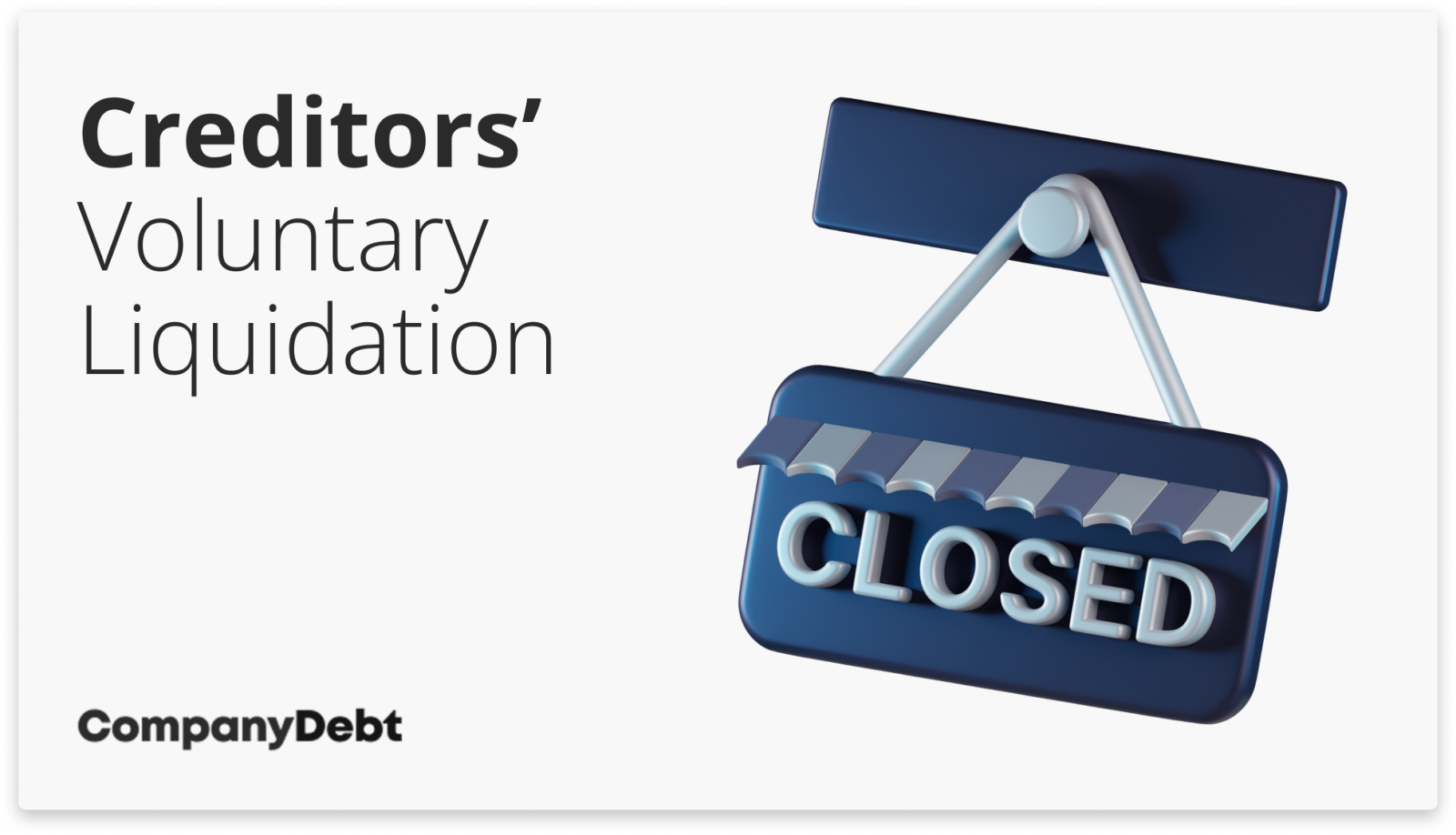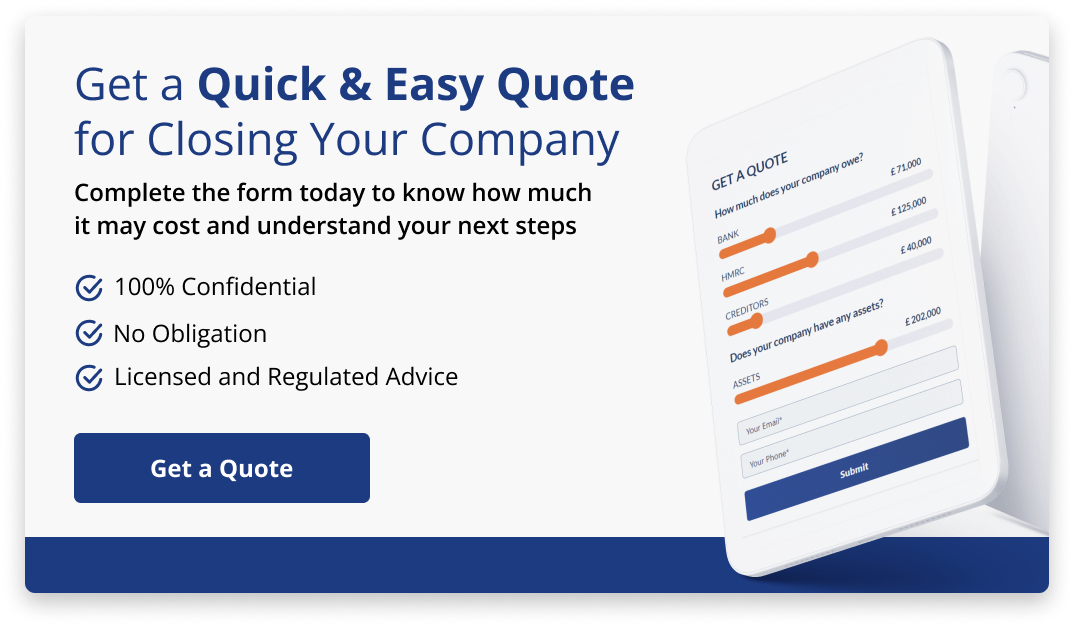
Understanding Creditors’ Voluntary Liquidation (CVL)
When a director realises a limited company is insolvent, there’s a decision to be made about whether there’s a chance to save the business or if it’s time to close down responsibly.
At this stage, continuing to trade while insolvent has the potential to worsen creditors’ positions and could lead to charges of wrongful trading later on.
The choice to liquidate means opting for a voluntary liquidation process known as Creditors’ Voluntary Liquidation (CVL).
>>Read our full article on the Advantages and Disadvantages of a Creditors’ Voluntary Liquidation

- What is a Creditors’ Voluntary Liquidation?
- How Does a CVL Work?
- Why Opt for Creditors’ Voluntary Liquidation (CVL)?
- What are the Immediate Consequences of Entering into a CVL?
- What are the Costs Associated with a CVL?
- How Long will the CVL Process Take?
- How Can Company Debt Help
- Creditors’ Voluntary Liquidation FAQs
What is a Creditors’ Voluntary Liquidation?
A Creditors’ Voluntary Liquidation (CVL) is a process initiated by the directors company that can no longer pay its debts.
It’s a voluntary decision to close and liquidate the company’s assets under the guidance of an appointed insolvency practitioner. It’s often chosen to prevent compulsory liquidation by creditors via a winding up petition.
The CVL process is designed to ensure that creditors receive the best possible return and are paid fairly.
It also offers directors a way to close the business responsibly, minimising potential legal repercussions.

How Does a CVL Work?
(1) Decision to Liquidate
The first step involves you, the director, acknowledging that the company cannot continue due to its debts
(2) Appointment of an Insolvency Practitioner
Once the decision is made, you will need to appoint a licensed insolvency practitioner (IP). This person acts as the liquidator, taking charge of the liquidation process. Their role is a legal requirement ensuring that assets are fairly valued and that creditors recoup as much as possible.
(3) Board Meeting
You must hold a board meeting to agree on the liquidation, and this decision should be documented in the company’s minutes.
(4) Shareholders’ Meeting
Following the board’s decision, shareholders must formally agree to the liquidation. This is typically done through a General Meeting, where at least 75% of votes (by share value) must be in favour of the CVL.
(5) Creditor Notification
The IP will send a report detailing the company’s assets and liabilities to all known creditors. This report invites creditors to a meeting, either physically or virtually, where they can vote on the liquidation process.
(6) Liquidation Process
The IP takes control of the company, selling off assets to repay creditors in order of priority. This includes dealing with outstanding contracts, employee claims, and any legal disputes.
(7) Distribution of Funds
After assets are liquidated, funds are distributed to creditors. This is done in a strict legal order, starting with secured creditors, followed by preferential creditors (like employees), and then unsecured creditors.
(8) Dissolution
Once the process is complete and funds distributed, the company is formally dissolved. This means it ceases to exist, and you are no longer a director.
We are here to assist if you need help navigating the complexities of Creditors’ Voluntary Liquidation. Whether you’re weighing your options or ready to initiate the CVL process, our team of experienced insolvency practitioners offers the guidance and support you need. Contact us today for a confidential discussion about your company’s path forward.
Why Opt for Creditors’ Voluntary Liquidation (CVL)?
As a company director, you may be considering if a Creditors’ Voluntary Liquidation (CVL) is the right path for your struggling business. Here’s when a CVL might offer the best way forward:
- You’re Having Serious Cash Flow Problems – If you’re unable to pay suppliers, creditors and employees when their bills come due, a CVL provides a legal process for you to close down operations in an orderly manner under the supervision of a licensed insolvency practitioner.
- Your Company Is Balance Sheet Insolvent – Even if cash flow is manageable day-to-day, a CVL may be the prudent choice if your company’s total liabilities far exceed its assets, leaving it balance sheet insolvent with no equity cushion.
- There’s No Viable Path Forward – A CVL allows you to properly wind down the company when there is no realistic way for the business to return to sustainable profitability and repay its accumulated debt.
- You Need to Protect Yourself from Liability – Entering a CVL instead of continuing to trade while insolvent can help protect you as a director from potential personal liability for wrongful trading claims.
- You are Facing Creditor Pressure – If you’re facing pressure such as a CCJ or a Winding up Petition, you may be forced into compulsory liquidation if you don’t take professional advice, and consider a CVL
What are the Immediate Consequences of Entering into a CVL?
When a director initiates a CVL, the impact on them and others in the company is significant.
Firstly, the director loses control over the company as a liquidator is appointed to manage the liquidation process. This means all powers to make decisions about the company’s operations and assets transfer to the liquidator.
For employees, this typically results in immediate job loss unless the liquidator finds it beneficial to keep operations running temporarily, which is rare.
Directors may also face scrutiny regarding their conduct and decisions leading up to the liquidation to ensure there has been no wrongful or fraudulent trading.
What are the Costs Associated with a CVL?
The costs associated with initiating and carrying out a Creditors’ Voluntary Liquidation (CVL) primarily include the liquidator’s fees, legal fees, and administrative expenses. The liquidator’s fees, which can vary significantly based on the complexity of the liquidation, are usually the largest expense and are typically £5-7k for a small company.
How Long will the CVL Process Take?
The duration of a Creditors’ Voluntary Liquidation (CVL) can vary but typically takes between 6 to 12 months to complete.
How Can Company Debt Help
To explore how Company Debt can assist you further with closing your company voluntarily, contact us today. We’re here to provide guidance and support a free initial consultation via practical advice, and step by step guidance.
Reach out to us via live chat, email us at info@companydebt.com, or give us a call at 0800 074 6757. Let us help you find the best path forward for your company’s financial future.
Creditors’ Voluntary Liquidation FAQs
What are the steps involved in a CVL?
The steps involved in a CVL include the appointment of a liquidator, the investigation of the company’s affairs by the liquidator, the sale of the company’s assets, and the distribution of the proceeds to the company’s creditors.
What happens to employees during a CVL?
During a CVL, the company’s employees will typically be made redundant, and will be entitled to claim any unpaid wages or redundancy pay from the government’s Redundancy Payments Office.
What happens to directors during a CVL?
During a CVL, the company’s directors may be held liable for any wrongful trading or other misconduct contributing to the company’s financial difficulties. They may also be required to provide information and assistance to the liquidator in investigating the company’s affairs.
What happens to the company’s creditors during a CVL?
During a CVL, the company’s creditors will be ranked in priority order, and will be paid from the proceeds of the sale of the company’s assets in accordance with that ranking. The company’s secured creditors, such as banks, will typically be paid first, followed by unsecured creditors such as suppliers and employees.
What happens to shareholders during a CVL?
During a CVL, the company’s shareholders will typically receive nothing, as the proceeds of the sale of the company’s assets are used to pay the company’s creditors.










